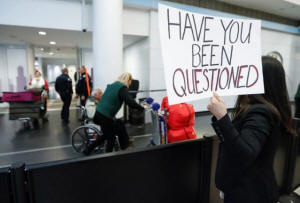|
Exclusive: Trump administration to allow
872 refugees into U.S. this week - document
 Send a link to a friend
Send a link to a friend
 [January 31, 2017]
By Julia Edwards Ainsley [January 31, 2017]
By Julia Edwards Ainsley
WASHINGTON (Reuters) - The U.S. government
has granted waivers to let 872 refugees into the country this week,
despite President Donald Trump's executive order on Friday temporarily
banning entry of refugees from any country, according to an internal
Department of Homeland Security document seen by Reuters.
A Homeland Security official, speaking on condition of anonymity,
confirmed the waivers, noting that the refugees were considered "in
transit" and had already been cleared for resettlement before the ban
took effect.
Refugees preparing for resettlement typically have severed personal ties
and relinquished their possessions, leaving them particularly vulnerable
if their plans to depart are suddenly canceled.
The waivers, granted by the State Department and the Department of
Homeland Security (DHS), came amid international protests against
Trump's rushed executive order. Critics said the order in some cases was
not clearly communicated to the agencies responsible for implementing
it.
It was not known if additional waivers would be granted, the official
said. The document did not give the nationalities of the refugees who
will be admitted into the United States.

Over the weekend, non-refugee visitors from seven majority-Muslim
countries also targeted in Trump's executive order were detained,
deported and in some cases blocked from boarding flights to the United
States.
The countries covered by the traveler ban were Iran, Iraq, Syria, Sudan,
Somalia, Libya and Yemen.
The internal DHS document said that between late Friday and early Monday
348 visa holders were prevented from boarding U.S.-bound flights. In
addition, more than 200 people landed in the United States but were
denied entry, the document showed.
More than 735 people were pulled aside for questioning by U.S. Customs
and Border Protection officers in airports, including 394 legal
permanent U.S. residents holding green cards, over the same time period.
Trump said the executive order he signed on Friday was designed to
protect the United States "from foreign terrorist entry."
The order stopped all refugee admissions for 120 days while government
officials determine how to ensure that any refugees admitted do not pose
a threat.
[to top of second column] |

Chicago area immigration attorney Diana Mendoza Pacheco offers her
assistance to arriving passengers at O'Hare airport in Chicago.
REUTERS/Kamil Krzaczynski

The 872 refugees to be admitted this week, under the waivers, were
screened using Obama administration procedures, which typically take
two years and include several interviews and a background check.
The DHS said on Sunday night that green card holders would be
allowed to board U.S.-bound flights, but would be subjected to
additional scrutiny upon arrival.
The public guidance from DHS also said some people from the seven
majority-Muslim countries could be allowed entry to the United
States on a case-by-case basis.
Congressional Democrats and some foreign countries, including key
U.S. allies, put pressure on Trump on Monday over the executive
order.
Democratic Senators tried to force a vote on a bill to rescind the
order, but were blocked by a Republican lawmaker. Democratic Senator
Dianne Feinstein said she had 27 co-sponsors for the legislation.
But under Senate rules it takes only one member to prevent a vote,
and Republican Senator Tom Cotton blocked consideration of the
measure.
The Democrats' leader in the U.S. Senate, Chuck Schumer, said he
would bring legislation on Monday evening seeking to end the ban,
although the measure stood little chance of being passed by the
Republican-led Congress.
(Reporting by Julia Edwards Ainsley; Editing by Kevin Drawbaugh and
Jonathan Oatis)
[© 2017 Thomson Reuters. All rights
reserved.]
Copyright 2017 Reuters. All rights reserved. This material may not be published,
broadcast, rewritten or redistributed.

 |